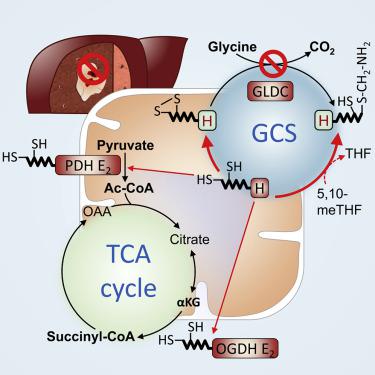Cell Metabolism ( IF 27.7 ) Pub Date : 2022-05-03 , DOI: 10.1016/j.cmet.2022.04.006 Dzmitry Mukha 1 , Mariam Fokra 2 , Alona Feldman 2 , Boris Sarvin 2 , Nikita Sarvin 2 , Keren Nevo-Dinur 2 , Elazar Besser 2 , Elior Hallo 2 , Elina Aizenshtein 2 , Zachary T Schug 3 , Tomer Shlomi 4

|
The folic acid cycle mediates the transfer of one-carbon (1C) units to support nucleotide biosynthesis. While the importance of serine as a mitochondrial and cytosolic donor of folate-mediated 1C units in cancer cells has been thoroughly investigated, a potential role of glycine oxidation remains unclear. We developed an approach for quantifying mitochondrial glycine cleavage system (GCS) flux by combining stable and radioactive isotope tracing with computational flux decomposition. We find high GCS flux in hepatocellular carcinoma (HCC), supporting nucleotide biosynthesis. Surprisingly, other than supplying 1C units, we found that GCS is important for maintaining protein lipoylation and mitochondrial activity. Genetic silencing of glycine decarboxylase inhibits the lipoylation and activity of pyruvate dehydrogenase and impairs tumor growth, suggesting a novel drug target for HCC. Considering the physiological role of liver glycine cleavage, our results support the notion that tissue of origin plays an important role in tumor-specific metabolic rewiring.
中文翻译:

甘氨酸脱羧酶维持线粒体蛋白脂酰化以支持肿瘤生长
叶酸循环介导单碳 (1C) 单元的转移以支持核苷酸生物合成。虽然丝氨酸作为叶酸介导的 1C 单位在癌细胞中的线粒体和胞质供体的重要性已被彻底研究,但甘氨酸氧化的潜在作用仍不清楚。我们开发了一种通过将稳定和放射性同位素示踪与计算通量分解相结合来量化线粒体甘氨酸裂解系统 (GCS) 通量的方法。我们在肝细胞癌 (HCC) 中发现高 GCS 通量,支持核苷酸生物合成。令人惊讶的是,除了提供 1C 单位外,我们发现 GCS 对于维持蛋白质脂酰化和线粒体活性很重要。甘氨酸脱羧酶的基因沉默抑制了丙酮酸脱氢酶的脂酰化和活性并损害了肿瘤的生长,提示HCC的新药物靶点。考虑到肝甘氨酸裂解的生理作用,我们的结果支持了起源组织在肿瘤特异性代谢重新布线中起重要作用的观点。











































 京公网安备 11010802027423号
京公网安备 11010802027423号